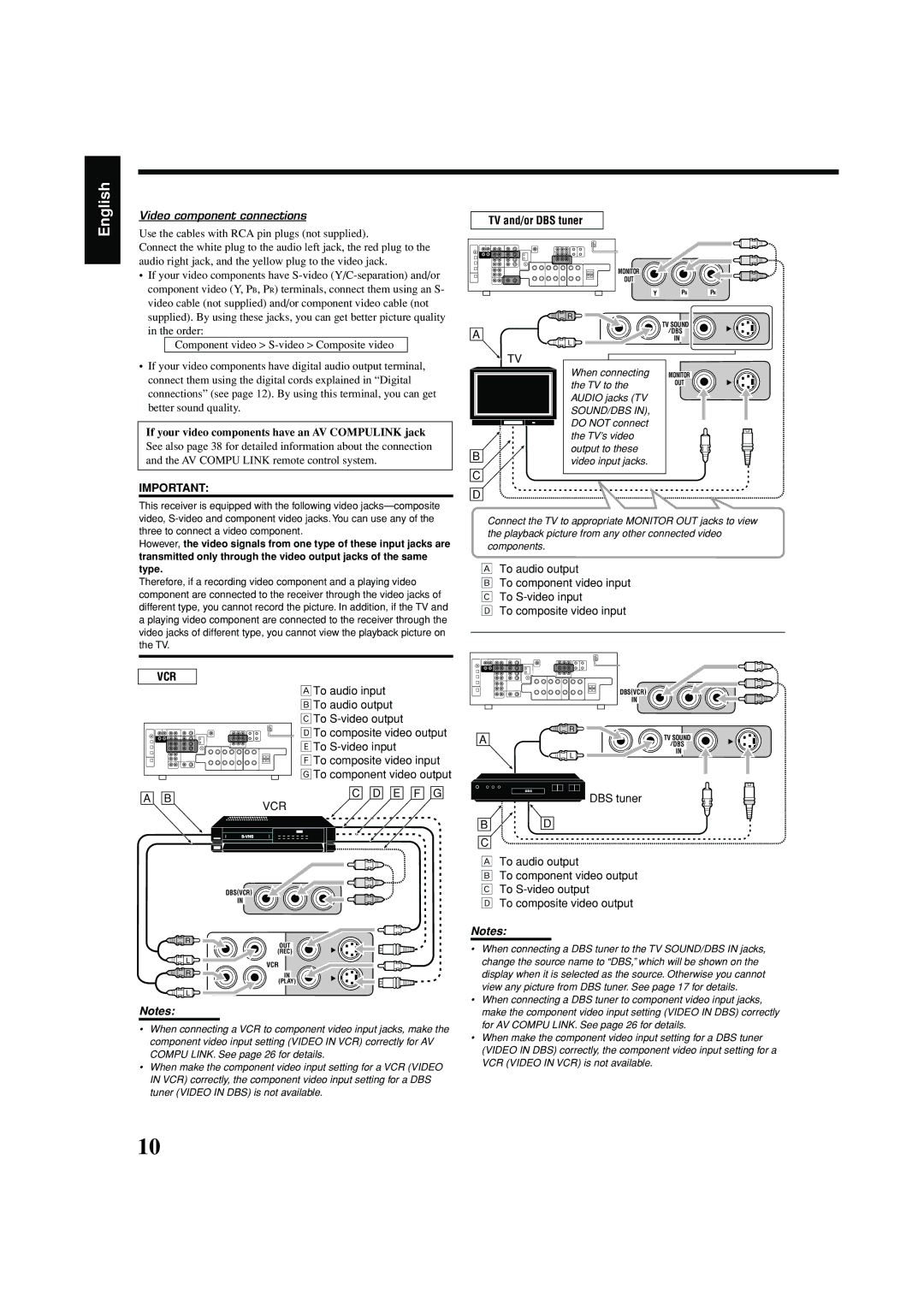
English
Video component connections
Use the cables with RCA pin plugs (not supplied).
Connect the white plug to the audio left jack, the red plug to the audio right jack, and the yellow plug to the video jack.
•If your video components have
Component video >
•If your video components have digital audio output terminal, connect them using the digital cords explained in “Digital connections” (see page 12). By using this terminal, you can get better sound quality.
If your video components have an AV COMPULINK jack
See also page 38 for detailed information about the connection and the AV COMPU LINK remote control system.
IMPORTANT:
This receiver is equipped with the following video
However, the video signals from one type of these input jacks are transmitted only through the video output jacks of the same type.
Therefore, if a recording video component and a playing video component are connected to the receiver through the video jacks of different type, you cannot record the picture. In addition, if the TV and a playing video component are connected to the receiver through the video jacks of different type, you cannot view the playback picture on the TV.
TV and/or DBS tuner
| MONITOR |
|
|
| OUT |
|
|
| Y | PB | PR |
| R | TV SOUND |
|
|
|
| |
A |
| DBS |
|
L | IN |
| |
|
|
| |
| TV |
|
|
| When connecting | MONITOR |
|
| the TV to the | OUT |
|
| AUDIO jacks (TV |
|
|
| SOUND/DBS IN), |
|
|
| DO NOT connect |
|
|
| the TV’s video |
|
|
B | output to these |
|
|
video input jacks. |
|
| |
|
|
|
C
D
Connect the TV to appropriate MONITOR OUT jacks to view the playback picture from any other connected video components.
ÅTo audio output
ıTo component video input Ç To
Î To composite video input
VCR
ÅTo audio input ıTo audio output ÇTo
ÎTo composite video output ‰To
ÏTo composite video input ÌTo component video output
|
| DBS(VCR) |
|
| IN |
A | R | TV SOUND |
| ||
| DBS | |
| L | IN |
|
|
A B
VCR
DBS(VCR)
IN
R | OUT |
| |
| (REC) |
L | VCR |
| |
R | IN |
| (PLAY) |
L |
|
Notes: |
|
C 
 D
D 
 E
E 
 F
F 
 G
G
| DBS |
| DBS tuner |
B | D |
C |
|
ÅTo audio output
ıTo component video output Ç To
Î To composite video output
Notes:
• When connecting a DBS tuner to the TV SOUND/DBS IN jacks, |
change the source name to “DBS,” which will be shown on the |
display when it is selected as the source. Otherwise you cannot |
view any picture from DBS tuner. See page 17 for details. |
• When connecting a DBS tuner to component video input jacks, |
make the component video input setting (VIDEO IN DBS) correctly |
for AV COMPU LINK. See page 26 for details. |
•When connecting a VCR to component video input jacks, make the component video input setting (VIDEO IN VCR) correctly for AV COMPU LINK. See page 26 for details.
•When make the component video input setting for a VCR (VIDEO IN VCR) correctly, the component video input setting for a DBS tuner (VIDEO IN DBS) is not available.
• When make the component video input setting for a DBS tuner |
(VIDEO IN DBS) correctly, the component video input setting for a |
VCR (VIDEO IN VCR) is not available. |
10
